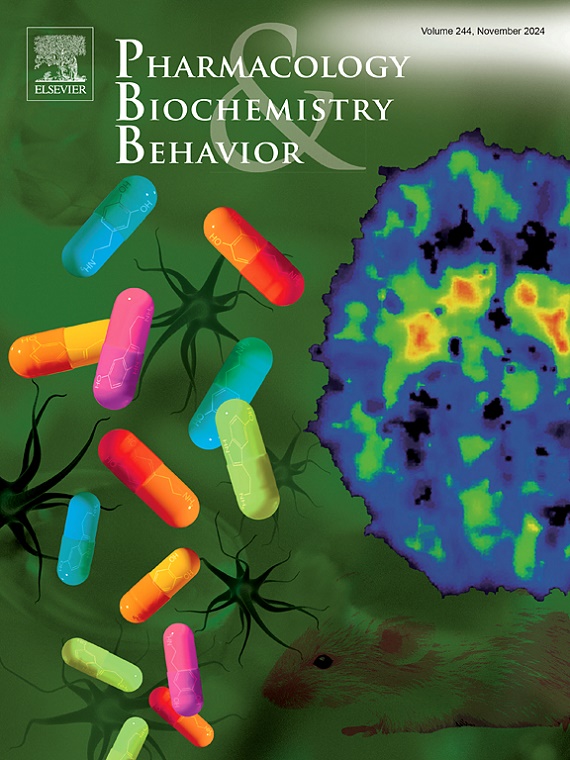Ketamine modulates the exploratory dynamics and homebase-related behaviors of adult zebrafish
IF 3.3
3区 心理学
Q1 BEHAVIORAL SCIENCES
引用次数: 0
Abstract
Anxiety can be a protective emotion when animals face aversive conditions, but is commonly associated with various neuropsychiatric disorders when pathologically exacerbated. Drug repurposing has emerged as a valuable strategy based on utilizing the existing pharmaceuticals for new therapeutic purposes. Ketamine, traditionally used as an anesthetic, acts as a non-competitive antagonist of the glutamate N-methyl-d-aspartate (NMDA) receptor, and shows potential anxiolytic and antidepressant effects at subanesthetic doses. However, the influence of ketamine on multiple behavioral domains in vertebrates is not completely understood. Here, we evaluated the potential modulatory effect of ketamine on the spatio-temporal exploratory dynamics and homebase-related behaviors in adult zebrafish using the open field test (OFT). Animals were exposed to subanesthetic concentrations of ketamine (0, 2, 20, and 40 mg/L) for 20 min and their locomotion-, exploration- and homebase-related behaviors were assessed in a single 30-min trial. Our data revealed that acute ketamine (20 and 40 mg/L) induced hyperlocomotion, as verified by the increased total distance traveled. All concentrations tested elicited circling behavior, a stereotyped-like response which gradually reduced across the periods of test. We also observed modulatory effects of ketamine on the spatio-temporal exploratory pattern, in which the reduced thigmotaxis and homebase activity, associated with the increased average length of trips, suggest anxiolytic-like effects. Collectively, our findings support the modulatory effects of ketamine on the spatio-temporal exploratory activity, and corroborate the utility of homebase-related measurements to evaluate the behavioral dynamics in zebrafish models.
氯胺酮能调节成年斑马鱼的探索动力和与家园相关的行为
焦虑是动物面对厌恶环境时的一种保护性行为,但当焦虑加剧时,通常会引发各种神经精神疾病。药物再利用已成为将现有药物用于新治疗目的的重要策略。氯胺酮传统上用作麻醉剂,是 N-甲基-d-天冬氨酸(NMDA)受体的非竞争性拮抗剂,有证据表明,在亚麻醉剂量下,氯胺酮具有潜在的抗焦虑和抗抑郁作用。然而,氯胺酮对脊椎动物多种行为领域的影响还不完全清楚。在这里,我们使用开放场试验(OFT)评估了氯胺酮对成年斑马鱼时空探索动态和归巢相关行为的潜在调节作用。将动物暴露于亚麻醉浓度的氯胺酮(0、2、20和40毫克/升)中20分钟,并在30分钟的单次试验中评估其运动、探索和归巢相关行为。我们的数据显示,氯胺酮(20和40毫克/升)可诱发过度运动,这一点可从总行程的增加得到验证。所有浓度的氯胺酮都会引起绕圈行为,这是一种类似于刻板印象的反应,这种反应在测试期间逐渐减弱。我们还观察到氯胺酮对时空探索模式的调节作用,其中前向运动和原基地活动的减少以及平均行程长度的增加都表明氯胺酮具有类似抗焦虑的作用。总之,我们的新发现支持氯胺酮对斑马鱼时空探索活动的调节作用,以及用原基相关测量来评估斑马鱼行为动态的实用性。
本文章由计算机程序翻译,如有差异,请以英文原文为准。
求助全文
约1分钟内获得全文
求助全文
来源期刊
CiteScore
6.40
自引率
2.80%
发文量
122
审稿时长
38 days
期刊介绍:
Pharmacology Biochemistry & Behavior publishes original reports in the areas of pharmacology and biochemistry in which the primary emphasis and theoretical context are behavioral. Contributions may involve clinical, preclinical, or basic research. Purely biochemical or toxicology studies will not be published. Papers describing the behavioral effects of novel drugs in models of psychiatric, neurological and cognitive disorders, and central pain must include a positive control unless the paper is on a disease where such a drug is not available yet. Papers focusing on physiological processes (e.g., peripheral pain mechanisms, body temperature regulation, seizure activity) are not accepted as we would like to retain the focus of Pharmacology Biochemistry & Behavior on behavior and its interaction with the biochemistry and neurochemistry of the central nervous system. Papers describing the effects of plant materials are generally not considered, unless the active ingredients are studied, the extraction method is well described, the doses tested are known, and clear and definite experimental evidence on the mechanism of action of the active ingredients is provided.

 求助内容:
求助内容: 应助结果提醒方式:
应助结果提醒方式:


